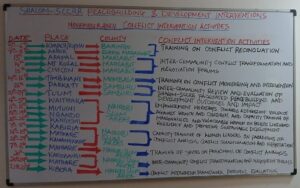By Patrick R. Devine, PhD, & Godfrey Okoth MA.
The life debilitating impact of Post-traumatic Stress Disorder (PTSD) on many war veterans and their families has been recently high profiled by Carol Lombard Clark, the Director and Producer of the award winning documentary ‘Caroline’s Dream’(https://www.imdb.com/title/tt9281098/ ;2018). According to Najavits (2002; 111), PTSD is by definition a disorder of powerlessness impacted by a terrible event occurring that the patient neither chose nor wanted. Psychological trauma is the result of extraordinarily stressful events that shatter one’s sense of security, making him/her feel helpless and vulnerable in a dangerous world (Akombo 2009). Undoubtedly, traumatic stress disorders result from experiences that overwhelm an individual’s capacity to cope. As such PTSD is a dreadful consequence of events that cause intense fear, helplessness, or horror, such as violent conflict-war, accidents, natural disasters, sexual or physical assault which can lead to the unexpected death of a loved one, physical injury, and loss of valued property or livelihood opportunity.
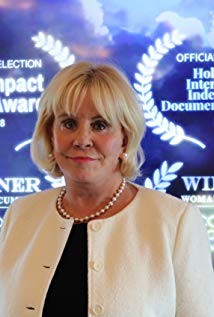

Trauma can result from many social dimensions of violence, abuse and neglect, witnessing acts of violence, sudden loss, and historical acts such as genocide and colonization. In such circumstances, victims (often comprising of women, children, aged, and the physically challenged), their families, emergency personnel and rescue workers can be traumatized to the point of developing PTSD (WEBMD, 2019). One critical step towards healing is to enable sufferers to begin regaining their sense of power by efforts such as, “naming the symptoms of PTSD and understanding that they are a ‘normal reaction to abnormal events’,” (Najavits 2002; 111).
The work of SCCRR is implemented among the pastoralist tribes in Northern Kenya and along the border with Ethiopia, South Sudan, Somalia and Uganda. In terms of ethnicity our interventions focus on the tribes living in Samburu, Marsabit, Turkana, West Pokot and Isiolo counties as well as the disputed Ilemi Triangle territory (South Sudan, Ethiopia, Kenya borderline). Additionally, Shalom works in urban environments especially in the slum areas of Nairobi, Kisumu and Nakuru. The role of Shalom in the prevention of election violence in Kenya over the years has attained world-wide coverage (BBC, Fergal Keane, 2017) there is grave shortage of trained psychological and appropriate medical staff in these areas to assist millions of people suffering from PTSD. SHALOM personnel operating in 15 violent conflict zones, apply all of their individual and qualified conflict transformation skills during analytical and mediation workshops, particularly at the personal, relational, structural and cultural levels, to assist the people suffering from PTSD. Most of the PTSD arises from the manifest violence of killing, maiming and displacement experienced from inter-ethnic and interreligious conflict issues and events.
In a recent interview on the issue of PTSD in conflict environments in Africa, Rev Dr. Patrick Devine (SHALOM-SCCRR’s International Chairman) gave a substantive analysis, from an Africa conflict perspective to Carol Lombard Clark, for a sequel to her documentary mentioned above. In a further interview for this article on the same issue he highlighted that,
“While conflict has a memory which is very resilient and moored in culture, its deep seated trauma and stress are embedded in the memory with detrimental consequences”. He added that, “while horrific conflict events are directly connected to PTSD, the conflict memory is negatively compounded further by false communal narratives of conflict; the conflict memory is frequently distorted by warped historical discourses that prolongs the trauma-stress disorders. Institutional and personal mendacious interests and agendas add to the complexity of these destructive narratives.
SHALOM-SCCRR, in its field work, is persistently doing all it can to address the underlying causes of conflict and bring healing and avenues of treatment for those suffering from post-traumatic stress disorder. These dimension are ever-present in our focus group discussions, negotiation and mediation forums, and problem solving interventions on issues of interethnic and interreligious conflict. Our work on radicalization and extremism, especially religious ideological extremism, often operationalized in slum areas around cities, such as Nairobi, raises its own specific challenges for our Shalom personnel. The need for more institutions with relevant qualified personnel in marginalized conflict/poverty environments to address PTSD cannot be emphasized enough. This is an urgent challenge to governments, well-meaning NGO’s and religious organizations, requiring immediate pragmatic responses”.
The conflict environments mentioned above, to various degrees, are characterized by dreadful killings, maiming, destruction of property, massive raiding of livestock which is the lifeline of the people, destruction of development opportunities and social amenities. Consequently, poverty, joblessness, illiteracy, sickness, death among others have been noted as major negative effects and conditions prevalent in the urban and rural environments where SCCRR work.
These are very traumatizing situations for women, children, men and all community members that interact with these situations nearly on a regular basis. Key incidents and conditions in the urban settlements instigating trauma cases include election related violence, rampant insecurity, fatal terrorist attacks, drug and substance abuse and interethnic and inter-religious animosities leading to frequent flare up of violence.
For example, the aftermath of the discrepancy-laden December 2007 Kenya general election resulted in more than 630,000 people displaced and 1,133 killed in towns such as Nakuru, Kisumu, Nairobi and Eldoret (Robertson & Olson, 2008).

Pre and post-election violence included excessive and calculated use of force for political intimidation, rape of women and girls and attacks and killing by armed youth militias against innocent civilians. Most affected areas were Nakuru County, the Nairobi County (Mathare and Kibera slums) and Kisumu/Nandi border that have experienced cycles of interethnic conflicts based on political disputes, disputed land boundaries, historical injustices among others.
Every life if important. One of SHALOM’s team members Asha Said Awed (MA candidate) shared that,
‘‘There is great need and value in assisting communities dealing with post traumatic experiences. Recently on two different occasions, I have witnessed participants break down as they narrate their experiences.

A participant in Mathare Shalom-SCCRR stakeholders group emotionally broke down during a workshop, on negotiation processes, as she narrated how her house was lit on fire and due to complications later lost her eye sight.Another participant, from Kariobangi at a Shalom workshop addressing issues of ‘identity based conflict’, also broke down as she narrated how her husband was killed, because he belonged to a different ethnic group during previous election related violence in Kenya.
She explained how the memory was still very fresh in her mind and feelings; the memory of that day is continually recurring.’’
SCCRR has focussed one arm of its work on the counties of Nairobi, Nakuru and Kisumu through peacebuilding training, and providng victims and their families with forums and platforms for dialogue and mediation. Issues of PTSD are ever present. At the heart of this process are factors of inter-tribal tensions, Religious ideological radicalization and extremism and the effects of the violence. Addressing underlying causes and mechanisms through which local communities can prevent future occurrence are key components in the dialogue and planning for joint development projects (dia-praxis) . Shalom-SCCRR has had immense success preventing election violence in two national elections since and its work has received high profile acclamation worldwide as Fergal Keane BBC rightly ascertained, “SCCRR already has a cohesive network of qualified and trained peace agents contributing to the prevention and management of possible electoral related violence at the grassroots level (Erot , 2017), and supported further by Terry Collins when he said, “The Shalom Center for Conflict Resolution and Reconciliation, founded by Fr. Patrick Devine in 2009, which works as well in the slums of Nairobi, has cultivated a unique approach to conflict resolution, its success recognized and celebrated with a host of international awards” (Terry Collins & Associates, 2017).
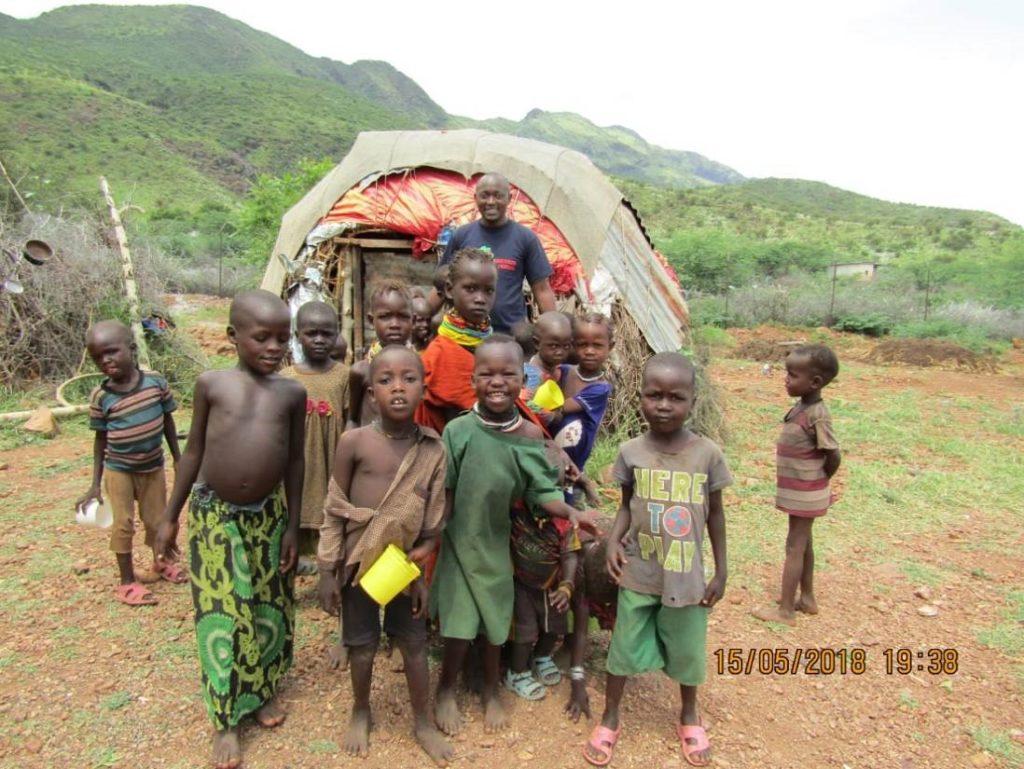
Kenyan-South Sudan border.
On the other hand, trauma indicators among the pastoralist communities with whom SCCRR presently works in Northern Kenya are: the chain of inter-ethnic attacks leading to killings, maiming, injury, loss and destruction of property, massive livestock theft and raiding leaving people poorer and poorer and entrenching deep seated enmity among tribal groups (Noonan and Kevlihan, 2018).
This added to the difficult weather conditions in the semi-arid area makes life unbearable to many pastoralist communities. Another case in point is a terrifying event that happened in Chumviyere Primary School located in Samburu/Isiolo border.
“Livestock were stolen from the Samburu by the Turkana raiding warriors. When the case was reported to the police, they responded with heavy force even bombing one of the Manyattas, such incidences are very traumatizing to the children, women, elderly and the whole community”, Gabriel Ilikwel (one of the village elders from Ngaremara) explained. Conflict incidences are frequent in this area and have impacted negatively on the communities especially the school going children. “I am still scared to date since the last time the event occurred,” One of the pupils from Chumviyere primary school exclaimed in one of the workshops.
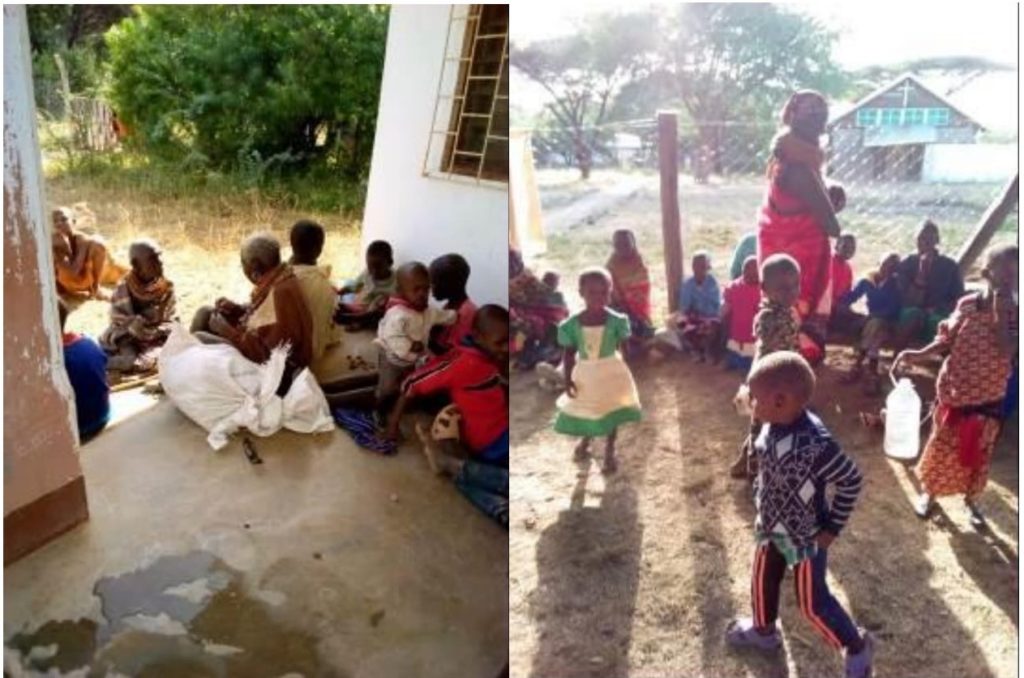
Communities in these conflict environments manifest traumatic experiences in different ways. Nova Scotia Health Authority in their 2015 report indicate that depression and substance misuse are among the common responses to trauma. SCCRR through its experience over years of interaction with the communities in conflict environments in both urban and pastoralist communities has observed that trauma manifests among individuals in ways such as; anxiety attacks, fear, rumors about impending attacks leading to emotional outbursts even before confirmation of the rumors, interethnic hatred that is not explainable, ethnic labelling, sudden killings, substance abuse, hopelessness, confusion among others. Effects of traumatic situations is clearly affirmed by Najavits (2002) when she opined that in both PTSD and substance abuse, patients can so lose touch with themselves that they cannot hear the message their own behaviour is sending to them. They may get into fights, isolate and stop taking adequate care of their bodies, yet not recognize that these are all communications of distress that require immediate attention.
SCCRR Framework of Intervention
To begin with, SCCRR conflict intervention framework is empirical research and analysis. SCCRR conducts empirical research and analysis of conflict situations in order to identify the root causes of conflict as the basis of long term conflict intervention. The conflict research and analysis approach has enabled the team not only to establish the root causes of the conflicts in the different project areas,

but also establish some of the grave impacts that such conflicts have on the personal behavior/attitudes of the people as well as the relations among them. Some of the characteristics that have been identified through research as manifestations of trauma among affected communities are; fear, greed, animosity, us vs them hatred, revenge, hopelessness, confusion, These findings have given a clearer understanding of people’s behavior thus providing a basis for creating interventions towards trauma recovery.
Secondly, SCCRR’s conflict intervention framework focusses on training. SCCRR conducts training on conflict resolution skills and peacebuilding techniques with a view of making the influential community leaders to be architects of their own interdependent future and that of their respective communities. Through the training workshops some of the SCCRR stakeholders had opportunities to confront the realities of their past experiences of trauma and pain in acceptance and forgiveness. A case in point is Wamboi who is one of the trained peacebuilding stakeholder in Kuresoi Nakuru County and who lost her entire family and property during the Post-Election Violence. In one of the SCCRR’s workshops conducted in June 2019, Jane Wambui shared how she journeyed through the Post-election trauma that resulted from this loss.
“Since 2007, I have lived in isolation, in fear, in pain and depression. My situation changed when I became part of SCCRR stakeholders for peace. Through the conflict resolution trainings, I was empowered and additionally, through the inter-community dialogue forums on reconciliation and conflict transformation, I found an opportunity to ventilate/ share my story with the others. If it were not for the SCCRR training and inter-community forum particularly on reconciliation, I would have died of depression.”
Thirdly, SCCRR’s conflict intervention framework focuses on intra and inter-community dialogue forums. These are gatherings through which conflicting communities negotiate and mediate prevailing conflict situations in order to seek an end to manifest violence and secure prevention of future violence. Through such inter-community dialogue fora on conflict transformation and peacebuilding, communities have found an opportunity to speak and ventilate about the horrors of conflict that they have been through and also to express their negative feelings to people who committed violent actions on them. Furthermore, SCCRR key stakeholders have been able to rebuild their lives from the ruin of the violence and left their isolations to start being the ambassadors of peace to their tribes and even other tribes. A case in point is the Turkana and West Pokot communities who have had a series of inter-ethnic attacks since the colonial times. Such conflict have led to the killings of the ethnic other, created bitterness and fear of the ethnic other, robbed these communities of livelihood and freedom of movements. Teresia Kiyonga lives in Kainuk (A center at the border of Turkana and West Pokot). She shared her painful experience in one of the workshops saying,
“The conflict is in this area has robbed us of our men who are the sole breadwinners in our families, it has robed us of our homes and our property. We live in fear and depression. We depend on aid for food, our children are traumatized because of the death of their fathers and the difficulty they have to endure, but with the Shalom-SCCRR, We have new hopes as the peace is being restored and the fear and enmity that existed between us and the Pokot is reducing and we are prepare to build new relationships.”
The fourth SCCRR conflict intervention framework is problem solving workshops. These are workshops whose aims are to bring conflicting communities together in order for them to jointly identify the root causes of their conflicts and to devise self-driven resolutions. Problem solving workshops have addressed some of the effects of conflicts such as intense fear among different ethnic communities. Through the problem solving workshops SCCRR has helped the communities to facilitate communication among the conflicting parties leading to greater interaction thus emergence of mutually acceptable solutions. This has enabled the communities to develop cognitive empathy, responsiveness to the needs of the other and joint thinking and working together as they come up with resolutions acceptable to both parties “Life does not have to be tragic. You with others help can write a new script (Najavits, 2002).
“On 2nd June 2019 just a few months before the SCCRR Intercommunity dialogue workshops in Nauyapong (West Pokot) and Lorenge’kippi (Turkana) a Turkana herder killed a Pokot herder in the grazing field, as usual, this could have led to an escalation of conflict but to the surprise of many, The SCCRR Peacebuilding stakeholder in Lorenge’kippi and Nauyapong who have been trained and empowered with skills in peacebuilding and conflict resolution, together with other community leaders and elders met in a neutral place and resolved the issue, thereby preventing an impending revenge attack and conflict escalation by extension. This preventive intervention to conflict impacts and trauma related with it.”
The Fifth SCCRR framework is Peace Education. Peace education which entails training to school going children and the young generation on the culture of peace. This framework also include development projects such as school infrastructure that enables a smooth learning process. SCCRR support needy schools most of which are located in areas that have been affected by conflict and violence for example, in Nairobi’s slums and poor settlements, women and children were particularly targeted for rape on account of their ethnicity, although some men too were similarly sodomized (KNCHR, 2008). SCCRR peace education project is designed to support the school children with skills in peacebuilding and conflict transformation. In addition, it gives the school children an opportunity to share their painful past experiences and receive proper support and help from the Peace patron that has been trained and empowered by the SCCRR project teams. Daniel, (A Shalom peace club patron for Marti Primary) said,
“The peace education program has helped our children against traumatic experiences. The conflict that happened around the school and the killings have led our school going children to live with a lot of fear, some of these pupils have lost their parents and have to live through a lot of struggle. Through the peace education, we journey with the affected pupils in order to help them create new meaning in their lives.”
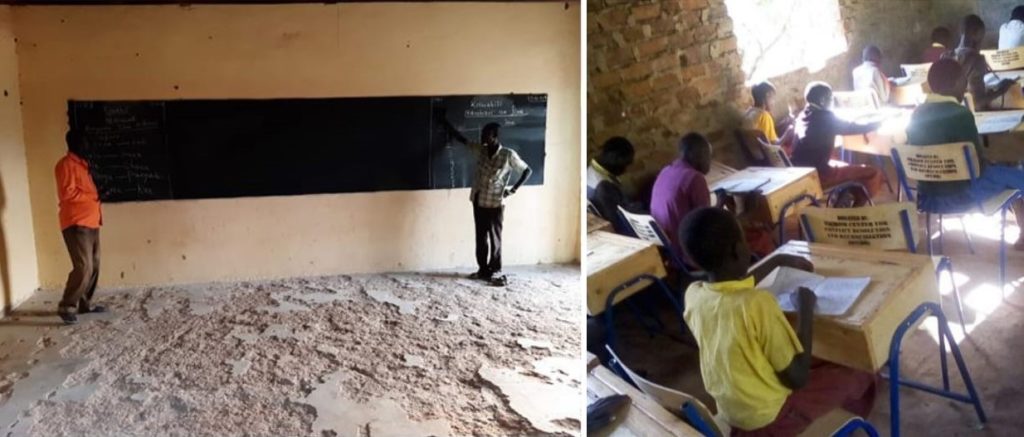
Informed by data from empirical research, SCCRR has designed conflict transformation programs and assists as much as it can address PTSD impacts in its areas of operation. SCCRR remains committed to implementing activities that focus on improving relationships among communities that have long suffered from direct impacts of conflicts, conflict trauma, and its related memory at the individual and communal levels.
REFERENCES.
- Akombo, D. O. (2009). Music and Healing During Post-Election Violence in Kenya. Voices: A World Forum for Music Therapy. Retrieved August 7, 2019 from https://voices.no/index.php/voices/article/view/1823/1586
- ‘Caroline’s Dream’ (https://www.imdb.com/title/tt9281098/).
- Devine P. (2017) Radicalization and Extremism in Eastern Africa: Dynamics and Drivers. Retrieved August 6, 2019, from https://www.maynoothuniversity.ie/edward-m-kennedy-institute/journal-mediation-and-applied-conflict-analysis
- Noonan O. & Kevlihan R. (2018) Managing conflict in north-west Kenya: The siege of Loregon and its aftermath, Conflict, Security & Development, 18:2, 137-157, DOI:
- Najavits, L. M. (2002). Seeking safety: A treatment manual for PTSD and substance abuse. New York: Guilford Press.
- Nova Scotia Health Authority. (2015). Addictions. Retrieved June 31, 2019, from Recognizing and Responding to the effects of trauma: https://novascotia.ca/dhw/addictions/documents/TIP_Discussion_Guide_2.pdf
- Robertson , A., & Olson, S. (2008). Arnessing operational systems engineering to support peacebuilding. Washington DC: The National Academy Press.
- http://www.terrycollinsassociates.com/2017/the-peace-builders-of-northern-kenya-model-expands-to-other-african-nations/
- 10.1080/14678802.2018.1447862
- Collins T. & Associates. (2017, July 2). Global Media Relations. Retrieved August 2, 2019, from Peacebuilders of Northern Kenya: Model Expands to other African Nations:
- Erot , P. (2017, October 30). Engagement on the Potential Peace and Conflict Issues during and after Kenya’s October 2017 Elections. Retrieved August 2, 2019, from Shalom-SCCRR: https://shalomconflictcenter.org/bbc-and-shalom-sccrr-confer/
- WebMD. (2019, June 29). Mental Health. Retrieved from Posttraumatic Stress disorder: https://www.webmd.com/mental-health/post-traumatic-stress-disorder#1

